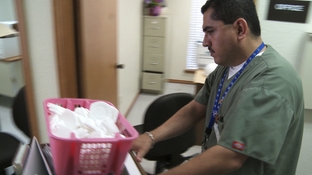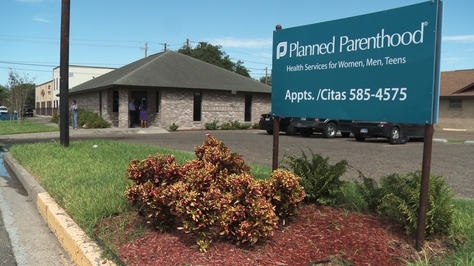Hidalgo County, situated along the border that separates Texas and Mexico, is home to one of the country's fastest-growing but poorest populations. Largely Hispanic and Catholic, the county also has one of the highest birth rates in a state where Medicaid finances more than half of all deliveries.
Not all of those new mothers and fathers are ready to be parents, and Patricio Gonzales, a former social worker in McAllen, the county's largest city, has witnessed the consequences — case after case of child neglect and abuse. Convinced that family planning could be a solution, he became the chief executive of the Planned Parenthood Association of Hidalgo County, which was founded in a Methodist church in nearby Mission.
In 2010, the Hidalgo County network's eight clinics provided family-planning services to 23,000 patients, many of whom are uninsured and cannot afford to pay. The services included contraception, breast and cervical cancer screenings, testing for sexually transmitted diseases, and wellness exams for both men and women — but not abortions.
"Basically, we are their doctors," Gonzales said. "And for many of them, this is a way to help them get out of poverty."
Operating in a region with a limited donor base and high need for health services, Gonzales said, the clinics have relied heavily on government financing. So when state cuts to family planning took effect in September, the Hidalgo County network lost a $3.1 million contract and was forced to lay off half its staff and shut down four of its facilities. (Another five clinics have closed around the state since the beginning of September.) Gonzales estimated that the closures would affect approximately 16,000 low-income men, women and teens in the Rio Grande Valley.
What is happening in Texas is emblematic of a national trend. Unable to overturn Roe v. Wade, anti-abortion rights campaigners have worked in recent years within Congress and state legislatures, many of which have become increasingly conservative, to make accessing the procedure as difficult as possible. Around the country, state legislatures from Arizona to Kansas have passed sweeping measures this year designed to make it more onerous for Planned Parenthood clinics to stay open.
In Texas, lawmakers approved a measure requiring doctors to perform sonograms on women seeking abortions and to describe to them what they see and hear. They also worked to strip financing from any organization that performs abortions or refers women to abortion providers, even if the majority of the organization's services — or all of them — are primary and preventive care.
"Taxpayers should not be subsidizing the abortion industry," said Elizabeth Graham, the director of Texas Right to Life.
Supporters of Planned Parenthood maintain that about 95 percent of the organization's services consist of routine health care. Planned Parenthood clinics receive state aid in Texas by legally separating their family planning services from their abortion services, which are off limits to tax dollars, but the distinction has never been enough to appease politicians who oppose abortion rights.
"Their interest is not in giving women options," state Rep. Wayne Christian, R-Center, said during this year's legislative session. "Their ultimate answer is, ‘The best we can do is an abortion.'"
Earlier this year, Christian and his colleagues cut the state's family planning budget by two-thirds, to $37.9 million over the next two years from $111.5 million. The money was diverted to other causes, including autism and early childhood programs. Budget analysts warned lawmakers that reducing family planning access would affect at least 180,000 men and women each year and could lead to more than 20,000 additional babies being born at a cost of more than $200 million.
Planned Parenthood reports that 66 of its Texas clinics remain open, but hours and educational outreach efforts have been reduced. This year, 11 clinics received state support, down from 40 clinics last year.
Anti-abortion rights activists say the women who have relied on Planned Parenthood can go to crisis pregnancy centers — for which lawmakers increased financing — and other community health clinics that do not refer for the procedure. But community health clinics have faced budget cuts as well.

In late August, the Department of State Health Services enforced a new priority financing system that determined that 56 family planning providers would receive smaller grants through November 2011. But 15 organizations would immediately lose their contracts because of "lack of need" or because there was another agency "within the same service area." Centers that lost financing included nine unaffiliated with Planned Parenthood, like the People's Community Clinic in Austin and Haven Health Clinics in Amarillo.
Lone Star Circle of Care, a federally qualified health center with locations throughout Central Texas, received some financing but not enough to cover the demand for birth control and testing.
"We're talking about basic primary things that everyone should be entitled to, and it really shouldn't be attached to any political or religious agenda," said Dr. Tamarah Duperval-Brownlee, Lone Star's chief medical officer.
In Hidalgo County, the Planned Parenthood network received a one-time award of $113,000 from the state in September after two other agencies rejected the money — enough to treat about 650 patients, but not enough to keep its clinics open in Mission, Progreso, Rio Grande City and San Carlos.
Gonzales said he was most concerned that clients would have to travel longer distances for care — or would stop seeking treatment altogether.
One of those clients, Nidia Torres, 62, of San Juan, started going to Planned Parenthood when she was 15. Torres said the organization helped her plan five pregnancies and treated early signs of cervical cancer in 1985.
Though she is staunchly opposed to abortion, Torres said she supports prevention. She is concerned that a desire to punish Planned Parenthood could have unintended consequences for the health of those in the community.
"If someone comes in and she's pregnant? She's pregnant. There's nothing we can do," Torres said. "We'll be worse if they take away that money for Planned Parenthood. The hospitals will be filled. We will have more children. We will need more food stamps. This is not what the Valley needs. This is not what our community needs. This is not what Texas needs."

